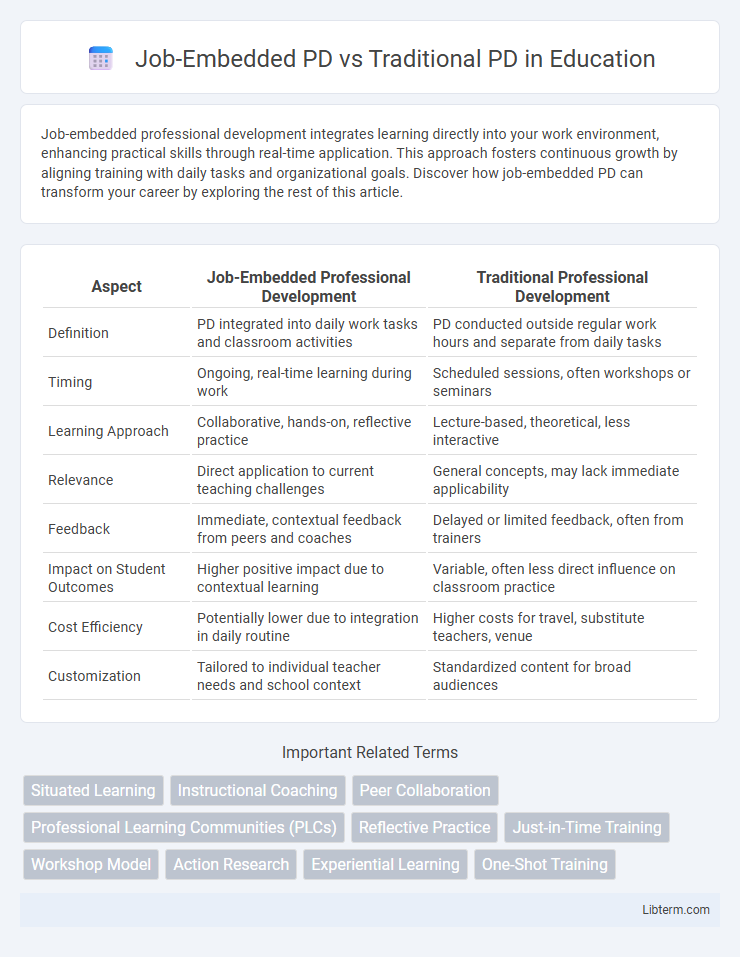Job-embedded professional development integrates learning directly into your work environment, enhancing practical skills through real-time application. This approach fosters continuous growth by aligning training with daily tasks and organizational goals. Discover how job-embedded PD can transform your career by exploring the rest of this article.
Table of Comparison
| Aspect | Job-Embedded Professional Development | Traditional Professional Development |
|---|---|---|
| Definition | PD integrated into daily work tasks and classroom activities | PD conducted outside regular work hours and separate from daily tasks |
| Timing | Ongoing, real-time learning during work | Scheduled sessions, often workshops or seminars |
| Learning Approach | Collaborative, hands-on, reflective practice | Lecture-based, theoretical, less interactive |
| Relevance | Direct application to current teaching challenges | General concepts, may lack immediate applicability |
| Feedback | Immediate, contextual feedback from peers and coaches | Delayed or limited feedback, often from trainers |
| Impact on Student Outcomes | Higher positive impact due to contextual learning | Variable, often less direct influence on classroom practice |
| Cost Efficiency | Potentially lower due to integration in daily routine | Higher costs for travel, substitute teachers, venue |
| Customization | Tailored to individual teacher needs and school context | Standardized content for broad audiences |
Introduction to Professional Development Models
Job-Embedded Professional Development (PD) integrates learning opportunities directly into educators' daily work, enhancing immediate application and relevance. Traditional PD typically involves standalone workshops or seminars conducted outside regular school hours, often lacking direct classroom connection. Research highlights that job-embedded PD leads to higher teacher engagement and sustained instructional improvement compared to traditional models.
Defining Job-Embedded Professional Development
Job-Embedded Professional Development (PD) integrates learning directly into the daily work environment, allowing educators to apply new skills in real-time and receive immediate feedback. Unlike Traditional PD, which often involves standalone workshops or seminars, Job-Embedded PD emphasizes continuous, collaborative, and context-specific growth aligned with teachers' specific classroom needs. This approach fosters sustained improvement by embedding professional learning into regular teaching practice rather than isolated events.
Understanding Traditional Professional Development
Traditional Professional Development (PD) typically involves scheduled workshops or seminars held outside regular work hours, emphasizing theoretical knowledge over practical application. It often lacks customization for individual educators' needs and does not provide ongoing support or immediate opportunities to implement new strategies. This format may result in limited retention and transfer of skills compared to Job-Embedded PD, which integrates learning directly into daily teaching practices.
Key Differences Between Job-Embedded and Traditional PD
Job-embedded professional development occurs within the daily work environment, promoting continuous learning aligned with specific job tasks, whereas traditional PD often takes place outside the classroom or workplace, such as workshops or seminars. Job-embedded PD emphasizes collaboration, real-time feedback, and personalized learning experiences, contrasting with the often generic, one-size-fits-all approach of traditional PD. This method enhances practical application and retention by integrating learning directly into teaching practices or job functions.
Impact on Teacher Learning and Practice
Job-embedded professional development integrates training within daily classroom activities, fostering immediate application of new strategies that enhance teacher learning and instructional practice. This approach leads to sustained behavioral changes and higher student achievement compared to traditional PD, which often occurs as isolated workshops with limited follow-up. Research shows job-embedded PD promotes collaboration and reflective practice, directly improving instructional methods and classroom outcomes.
Benefits of Job-Embedded PD
Job-Embedded Professional Development (PD) offers continuous, context-specific learning that directly aligns with teachers' daily classroom challenges, enhancing immediate application and effectiveness. This approach fosters collaboration among educators, leading to shared best practices and sustained improvement in instructional strategies. By integrating PD into regular work routines, job-embedded PD promotes deeper understanding and long-term retention compared to the episodic nature of traditional PD sessions.
Limitations of Traditional PD Approaches
Traditional professional development (PD) approaches often face limitations such as lack of ongoing support and insufficient alignment with teachers' specific classroom needs, resulting in minimal impact on instructional practices. These methods typically involve one-time workshops or seminars that fail to provide continuous feedback or opportunities for practical application. Consequently, educators may struggle to translate new knowledge into effective teaching strategies, hindering overall student achievement improvement.
Case Studies: Successful Job-Embedded PD Initiatives
Case studies reveal that job-embedded professional development (PD) leads to higher teacher engagement and improved student outcomes compared to traditional PD formats. For instance, Chicago Public Schools implemented job-embedded PD through collaborative lesson planning and real-time coaching, resulting in measurable gains in literacy scores. Similarly, Baltimore County Public Schools reported increased teacher retention and enhanced instructional practices by integrating PD within daily teaching routines.
Implementation Challenges and Solutions
Job-embedded professional development (PD) faces implementation challenges such as limited time during instructional hours, inconsistent administrative support, and difficulty in aligning PD activities with immediate classroom needs. Solutions include integrating PD into daily teaching routines, fostering strong leadership to prioritize ongoing skill development, and using collaborative approaches like peer coaching and real-time feedback to ensure relevance and practical application. Unlike traditional PD, which often occurs outside of school hours with standardized content, job-embedded PD demands adaptive structures that emphasize continuous, context-specific learning to overcome obstacles effectively.
Future Trends in Professional Development for Educators
Job-embedded professional development (PD) integrates learning directly into teachers' daily work, promoting continuous skill enhancement aligned with classroom realities, whereas traditional PD often involves isolated workshops with limited follow-up. Emerging trends emphasize personalized, technology-driven job-embedded PD leveraging real-time data analytics, virtual coaching, and collaborative platforms to support sustained growth. Future professional development will increasingly focus on adaptive learning environments that foster reflective practice and peer-driven innovation within educators' workflows.
Job-Embedded PD Infographic

 libterm.com
libterm.com